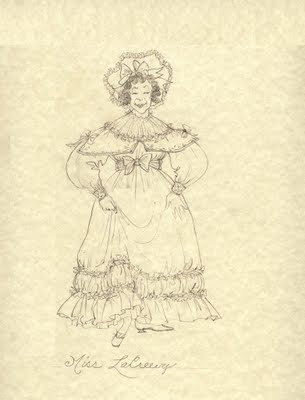How does a hat go from page to stage? Let’s follow the progress of Miss LaCreevey’s hat from design to reality!
First, as a milliner, i receive a costume design and some research from the costume designer. I also get a sheet with head measurements for the actors (or, i take them myself) so i know what size the hats need to be. If there will be wigs worn, i know to accommodate for that by making them a bit larger than the actor’s unwigged head measurement.
Here is Costume Designer Jan Chambers’ rendering for the character of Miss LaCreevey, who will be played by DeDe Corvinus. Look at this great hat!
In addition to the design rendering, Jan also gave me this research image of a portrait from the period:

When it comes to making this hat, physically, the question is: what does the back of it look like? Sometimes a designer will draw the hat from all angles, or provide a research image that answers the question, but in this case, Jan had to do 95 renderings, and i feel like this is one of those times when we need to look at the “big picture” of collaborative process: I did my own research to find the answer.
This image is from a fashion magazine from the period, which is a great way to get back views for headwear, on the millinery focus pages. Look, there are TWO back views of hats of this style!
I knew from talking to Jan that she wanted the brim of this bonnet to be transparent fabric on a wire frame, like the one in the painting. For our first round of fittings, a mockup needs to be made, so we can look at it on Ms. Corvinus’ head and fit it properly, check the scale of it compared to the costume itself, and generally decide how we want it to physically look. I created a draft of the wire frame structure and put it together from cheap craft wire and some inexpensive lace. The real bonnet will have a millinery wire foundation and nice quality fabric, but because a mockup might be drawn on, cut into, reformed, or destroyed in the process of a fitting, we make it out of lower-quality materials first.
Here is the mockup wire foundation, laying on top the “wire map” draft i used to shape it:
…and here it is with a lace cover and cloth cap:



